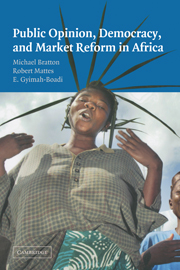Book contents
- Frontmatter
- Contents
- List of Tables and Figures
- Acknowledgments
- Introduction
- PART I FRAMEWORK
- PART II POPULAR ATTITUDES TO REFORM
- PART III COMPETING EXPLANATIONS
- 6 The Structure of Society
- 7 Cultural Values
- 8 Awareness of Public Affairs
- 9 Performance Evaluations
- 10 Institutional Influences
- PART IV EXPLAINING REFORM CONSTITUENCIES
- Conclusions
- Appendices
- Notes
- Index
- Cambridge Studies in Comparative Politics
6 - The Structure of Society
Published online by Cambridge University Press: 15 December 2009
- Frontmatter
- Contents
- List of Tables and Figures
- Acknowledgments
- Introduction
- PART I FRAMEWORK
- PART II POPULAR ATTITUDES TO REFORM
- PART III COMPETING EXPLANATIONS
- 6 The Structure of Society
- 7 Cultural Values
- 8 Awareness of Public Affairs
- 9 Performance Evaluations
- 10 Institutional Influences
- PART IV EXPLAINING REFORM CONSTITUENCIES
- Conclusions
- Appendices
- Notes
- Index
- Cambridge Studies in Comparative Politics
Summary
It is one thing to describe the features of public opinion, but quite another to explain the mechanisms of its formation. To test competing explanations, we shift from description to analysis. Parts III and IV of this book are designed, through a gradual process of accretion, to build comprehensive accounts of the sources of public opinion across Afrobarometer countries. To simplify the task, Part III focuses on just two paired objects of inquiry. On political reform, we seek to understand the sources of popular commitment to democracy and mass perceptions of democracy's extent. With reference to economic reform, we examine popular support for, and satisfaction with, the core policies that comprise structural adjustment programs. Later, in Part IV, we turn separately to behavior, endeavoring to understand why some people participate in the political arena and economic marketplace, whereas others do not.
The first question is whether the structure of society has any bearing on the ways that Africans approach the reform agenda. Just because people support democracy and oppose economic restructuring in many African countries does not mean that regime preferences are evenly distributed throughout the population. An individual's position in prevailing social hierarchies — of age, gender, occupation, or social class — are liable to strongly shape his or her opinions on the important issues of the day. For example, Afrobarometer results can arbitrate a dispute from other world regions about the role of young urbanites: are they the vanguards or the laggards of political and economic liberalization?
- Type
- Chapter
- Information
- Public Opinion, Democracy, and Market Reform in Africa , pp. 163 - 184Publisher: Cambridge University PressPrint publication year: 2004



